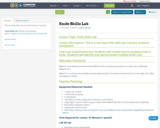
This is a knife skills lab used with Culinary 1 students.
- Subject:
- Career and Technical Education
- Culinary Arts
- Material Type:
- Activity/Lab
- Lesson
- Lesson Plan
- Date Added:
- 11/03/2019

This is a knife skills lab used with Culinary 1 students.
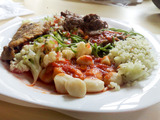
la descripción de los alimentos es para visualizar su importancia, especialmente, en Guatemala ya que no se da la debida importancia a este tema, vital para el desarrollo del pais, por las diferentes caracteristicas de los alimentos.

Šī informatīvā grāmata ir no Vašingtonas Universitātes Latviešu valodas pirmā gada kursa, 2023.
Word Count: 2279
(Note: This resource's metadata has been created automatically as part of a bulk import process by reformatting and/or combining the information that the author initially provided. As a result, there may be errors in formatting.)
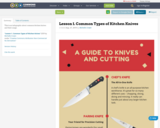
This is an infographic about common kitchen knives and their usage.
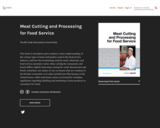
Short Description:
This book is intended to give students a basic understanding of the various types of meat and poultry used in the food service industry, and how the terminology used by retail, wholesale, and food service customers varies. Meat cutting for restaurants and hotels differs slightly from meat cutting for retail. Restaurants and hotels sometimes use names of cuts on menus that are common in the kitchen vernacular or in other jurisdictions like Europe or the United States, while retail meat cutters are bound by Canadian regulations regarding labelling and marketing of meat products to consumers for retail.
Long Description:
This book is intended to give students a basic understanding of the various types of meat and poultry used in the food service industry, and how the terminology used by retail, wholesale, and food service customers varies. Meat cutting for restaurants and hotels differs slightly from meat cutting for retail. Restaurants and hotels sometimes use names of cuts on menus that are common in the kitchen vernacular or in other jurisdictions like Europe or the United States, while retail meat cutters are bound by Canadian regulations regarding labelling and marketing of meat products to consumers for retail.
Meat Cutting and Processing for Food Service is one of a series of Culinary Arts books developed to support the training of students and apprentices in British Columbia’s food service and hospitality industry. Although created with the Professional Cook and Baker programs in mind, these have been designed as a modular series, and therefore can be used to support a wide variety of programs that offer training in food service skills.
Word Count: 20994
ISBN: 978-1-989623-09-1
(Note: This resource's metadata has been created automatically by reformatting and/or combining the information that the author initially provided as part of a bulk import process.)
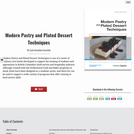
Short Description:
Modern Pastry and Plated Dessert Techniques is one of a series of Culinary Arts books developed to support the training of students and apprentices in British Columbia’s food service and hospitality industry. Although created with the Professional Cook and Baker programs in mind, these have been designed as a modular series, and there for can be used to support a wide variety of programs that offer training in food service skills.
Long Description:
Modern Pastry and Plated Dessert Techniques is one of a series of Culinary Arts books developed to support the training of students and apprentices in British Columbia’s food service and hospitality industry. Although created with the Professional Cook and Baker programs in mind, these have been designed as a modular series, and there for can be used to support a wide variety of programs that offer training in food service skills.
Other books in the series include: Food Safety, Sanitation, and Personal Hygiene Working in the Food Service Industry Workplace Safety in the Food Service Industry Meat Cutting and Processing Human Resources in the Food Service and Hospitality Industry Nutrition and Labelling for the Canadian Baker Understanding Ingredients for the Canadian Baker Basic Kitchen and Food Service Management
The series has been developed collaboratively with participation from public and private post-secondary institutions.
Word Count: 14359
ISBN: 978-1-7753524-3-3
(Note: This resource's metadata has been created automatically by reformatting and/or combining the information that the author initially provided as part of a bulk import process.)

Short Description:
Modern Pastry and Plated Dessert Techniques is one of a series of Culinary Arts books developed to support the training of students and apprentices in British Columbia’s food service and hospitality industry. Although created with the Professional Cook and Baker programs in mind, these have been designed as a modular series, and there for can be used to support a wide variety of programs that offer training in food service skills.
Long Description:
Modern Pastry and Plated Dessert Techniques is one of a series of Culinary Arts books developed to support the training of students and apprentices in British Columbia’s food service and hospitality industry. Although created with the Professional Cook and Baker programs in mind, these have been designed as a modular series, and there for can be used to support a wide variety of programs that offer training in food service skills.
Other books in the series include: Food Safety, Sanitation, and Personal Hygiene Working in the Food Service Industry Workplace Safety in the Food Service Industry Meat Cutting and Processing Human Resources in the Food Service and Hospitality Industry Nutrition and Labelling for the Canadian Baker Understanding Ingredients for the Canadian Baker Basic Kitchen and Food Service Management
The series has been developed collaboratively with participation from public and private post-secondary institutions.
Word Count: 14722
(Note: This resource's metadata has been created automatically as part of a bulk import process by reformatting and/or combining the information that the author initially provided. As a result, there may be errors in formatting.)

For this lesson you will be sharing the Soups and Sauces Powerpoint with the students while they take notes using the gudied notes page provdied. After the information has been presented, students will be able to participate in making a mother sauce of their own. They will have the option of creating a homemade mac n' cheese using a bechamel sauce base or a homemamde spaghetti sauce using a tomato sauce base. This Lesson Aligns with Utah State Standards for Foods 2: Strand 7: Standards 1-3 Performance Objective 7
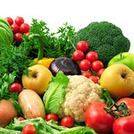
Assignment guiding students throught the my plate website and teaching them the different requirements for each
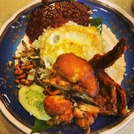
Nasi lemak is a Malay fragrant rice dish cooked in coconut milk and pandan leaf. It is commonly found in Malaysia, where it is considered the national dish; it is also popular in neighbouring areas such as Singapore; Brunei, and Southern Thailand. The best nasi lemak comes from Penang. Price : RM1.00 to RM10.00

Nasi lemak is a Malay fragrant rice dish cooked in coconut milk and pandan leaf. It is commonly found in Malaysia, where it is considered the national dish; it is also popular in neighbouring areas such as Singapore; Brunei, and Southern Thailand.
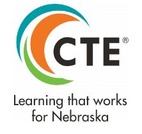
Career videos show the types of work in which individuals employed in a career field, cluster or pathway are engaged. Nebraska Career Education, in cooperation with the Nebraska Departments of Labor and Economic Development, offers an array of virtual career tours of Nebraska-based businesses and industries. Discussion guides for the teacher and viewing guides for students have been developed for each career tour. These virtual industry tours provide a unique opportunity to get a glimpse inside Nebraska-based industries without leaving the classroom. Interviews, tours of the business environment and “pop-up” information and statistics on job markets, salaries, and educational requirements are part of each career cluster’s videos.
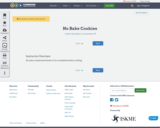
No bake cookies/worksheet to be completed before cooking

v. 2.0
Short Description:
This book is designed as an Open Education Resource (OER) for introductory nutrition courses and has been adopted for use in high schools and colleges. Topics covered include basic nutrition and metabolism, information literacy, body weight and health, nutrition across life stages, dietary supplements, an in-depth look at each of the macronutrients, and major functions of vitamins and minerals. The second edition of Nutrition: Science and Everyday Application was released in August 2022. The second edition includes a fully revised Unit 7 (Body Weight and Health) and minor revisions to Unit 10 (Nutrition and Physical Activity). The remainder of the OER and the accompanying ancillary materials are the same as the first edition, originally published in December 2020.
Word Count: 143844
(Note: This resource's metadata has been created automatically by reformatting and/or combining the information that the author initially provided as part of a bulk import process.)

v. 2.0
Short Description:
This book is designed as an Open Education Resource (OER) for introductory nutrition courses and has been adopted for use in high schools and colleges. Topics covered include basic nutrition and metabolism, information literacy, body weight and health, nutrition across life stages, dietary supplements, an in-depth look at each of the macronutrients, and major functions of vitamins and minerals. The second edition of Nutrition: Science and Everyday Application was released in August 2022. The second edition includes a fully revised Unit 7 (Body Weight and Health) and minor revisions to Unit 10 (Nutrition and Physical Activity). In June 2023, Unit 2 (Nutrition Science and Information Literacy) was significantly updated along with the ancillary materials for Unit 2. The remainder of the OER and the accompanying ancillary materials are the same as the first edition, originally published in December 2020.
Word Count: 157331
(Note: This resource's metadata has been created automatically by reformatting and/or combining the information that the author initially provided as part of a bulk import process.)

v. 2.0
Short Description:
This book is designed as an Open Education Resource (OER) for introductory nutrition courses and has been adopted for use in high schools and colleges. Topics covered include basic nutrition and metabolism, information literacy, body weight and health, nutrition across life stages, dietary supplements, an in-depth look at each of the macronutrients, and major functions of vitamins and minerals. The second edition of Nutrition: Science and Everyday Application was released in August 2022. The second edition includes a fully revised Unit 7 (Body Weight and Health) and minor revisions to Unit 10 (Nutrition and Physical Activity). The remainder of the OER and the accompanying ancillary materials are the same as the first edition, originally published in December 2020.
Word Count: 145510
(Note: This resource's metadata has been created automatically by reformatting and/or combining the information that the author initially provided as part of a bulk import process.)
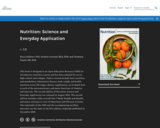
v. 2.0
Short Description:
This book is designed as an Open Education Resource (OER) for introductory nutrition courses and has been adopted for use in high schools and colleges. Topics covered include basic nutrition and metabolism, information literacy, body weight and health, nutrition across life stages, dietary supplements, an in-depth look at each of the macronutrients, and major functions of vitamins and minerals. The second edition of Nutrition: Science and Everyday Application was released in August 2022. The second edition includes a fully revised Unit 7 (Body Weight and Health) and minor revisions to Unit 10 (Nutrition and Physical Activity). In June 2023, Unit 2 (Nutrition Science and Information Literacy) was significantly updated along with the ancillary materials for Unit 2. The remainder of the OER and the accompanying ancillary materials are the same as the first edition, originally published in December 2020.
Word Count: 159133
(Note: This resource's metadata has been created automatically by reformatting and/or combining the information that the author initially provided as part of a bulk import process.)
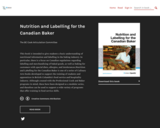
Short Description:
This book is intended to give students a basic understanding of nutritional information and labelling in the baking industry. In particular, there is a focus on Canadian regulations regarding labelling and merchandising of baked goods, as well as baking for customers with special diets, allergies, and intolerances.Nutrition and Labelling for the Canadian Baker is one of a series of Culinary Arts books developed to support the training of students and apprentices in British Columbia’s food service and hospitality industry. Although created with the Professional Cook and Baker programs in mind, these have been designed as a modular series, and therefore can be used to support a wide variety of programs that offer training in food service skills.
Long Description:
This book is intended to give students a basic understanding of nutritional information and labelling in the baking industry. In particular, there is a focus on Canadian regulations regarding labelling and merchandising of baked goods, as well as baking for customers with special diets, allergies, and intolerances.
Nutrition and Labelling for the Canadian Baker is one of a series of Culinary Arts books developed to support the training of students and apprentices in British Columbia’s food service and hospitality industry. Although created with the Professional Cook and Baker programs in mind, these have been designed as a modular series, and therefore can be used to support a wide variety of programs that offer training in food service skills.
Other books in the series include: Basic Kitchen and Food Service Management Food Safety, Sanitation, and Personal Hygiene Human Resources in the Food Service and Hospitality Industry Meat Cutting and Processing for Food Service Modern Pastry and Plated Desserts Understanding Ingredients for the Canadian Baker Working in the Food Service Industry Workplace Safety in the Food Service Industry
The series has been developed collaboratively with participation from public and private postsecondary institutions.
Word Count: 17007
ISBN: 978-1-989623-07-7
(Note: This resource's metadata has been created automatically by reformatting and/or combining the information that the author initially provided as part of a bulk import process.)

Short Description:
This book is intended to give students a basic understanding of nutritional information and labelling in the baking industry. In particular, there is a focus on Canadian regulations regarding labelling and merchandising of baked goods, as well as baking for customers with special diets, allergies, and intolerances.Nutrition and Labelling for the Canadian Baker is one of a series of Culinary Arts books developed to support the training of students and apprentices in British Columbia’s food service and hospitality industry. Although created with the Professional Cook and Baker programs in mind, these have been designed as a modular series, and therefore can be used to support a wide variety of programs that offer training in food service skills.
Long Description:
This book is intended to give students a basic understanding of nutritional information and labelling in the baking industry. In particular, there is a focus on Canadian regulations regarding labelling and merchandising of baked goods, as well as baking for customers with special diets, allergies, and intolerances.
Nutrition and Labelling for the Canadian Baker is one of a series of Culinary Arts books developed to support the training of students and apprentices in British Columbia’s food service and hospitality industry. Although created with the Professional Cook and Baker programs in mind, these have been designed as a modular series, and therefore can be used to support a wide variety of programs that offer training in food service skills.
Other books in the series include: Basic Kitchen and Food Service Management Food Safety, Sanitation, and Personal Hygiene Human Resources in the Food Service and Hospitality Industry Meat Cutting and Processing for Food Service Modern Pastry and Plated Desserts Understanding Ingredients for the Canadian Baker Working in the Food Service Industry Workplace Safety in the Food Service Industry
The series has been developed collaboratively with participation from public and private postsecondary institutions.
Word Count: 16628
ISBN: 978-1-998755-34-9
(Note: This resource's metadata has been created automatically by reformatting and/or combining the information that the author initially provided as part of a bulk import process.)
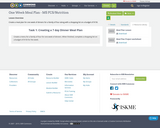
Create a meal plan for one week of dinners for a family of four along with a shopping list on a budget of $150.